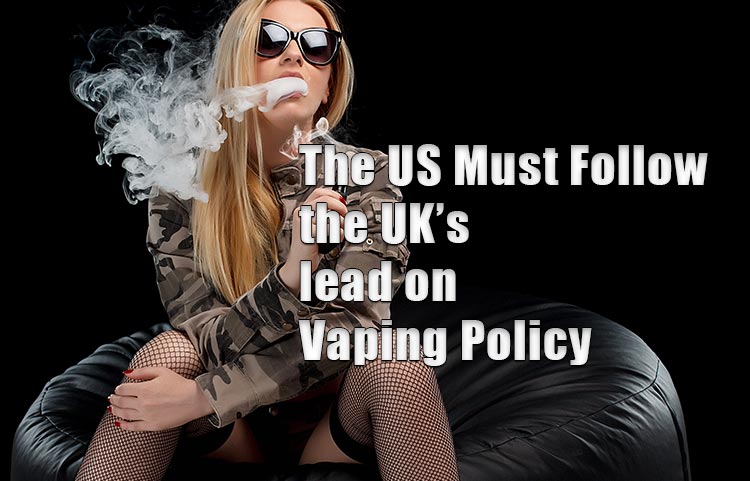Table of Contents [show]
...while they work for understanding and acceptance, we continue to blindly ban vaping...
It recently came to light that the British government “gets it” when it comes to vaping regulation and legislation. Sure, maybe we’re a little biased, but there’s something encouraging about a national government coming together to support people, rather than alienate them.
In this report, British officials are calling for employers to accommodate the growing contingent of vapers in the workforce by better defining what vaping products are in comparison to traditional cigarette and cigar smoking. The ultimate goal would be to allow e-cigarettes and vape devices to be used in designated indoor areas, away from smokers.

In turn, the UK is also considering a set of proposals to encourage smokers to make the switch to vaping post-haste. “The proposal”, put forth by the nation’s “All Party Parliamentary Group for Vaping”, establishes five recommendations that help establish vaping as a safer alternative to smoking, defining a realistic approach for all involved. The highlights include:
- Establishing vaping-specific workplace policies that address the needs of vapers, and potential ex-smokers.
- Developing public vaping policies that aren’t just extensions of existing smoking policies.
- Better establishment and designation of vaping areas in workplaces.
- Better promotion of vaping awareness programs, and stronger public understanding of vaping facts and common myths.
- Better education to vapers about more-responsible, aware vaping in public places.
This is pretty refreshing to hear, considering the United States’ primary vaping study can be boiled down to three words – “let’s ban this.” Let’s see what’s happening on our shores.
Meanwhile, in the United States…
The US, in direct contrast to the UK, continues to focus on spreading the word of a teenage vaping epidemic. The Centers for Disease Control and Prevention (CDC) claims that teen vaping has increased 78% since this point last year, with a reported 21% of high school students now using vapes, such as the ubiquitous JUUL pod mod devices.
If this was completely proven and substantiated, we would be more concerned – vaping is an adult practice, and we’ll never stray from that belief. But the problem here lies in the quality of this data used to spread these sensationalist claims. While the survey was indeed conducted nationwide, the CDC counted all claims of use as regular use.
In other words, if a teenager claimed they had used a vape once in the previous 30 days – even a passive puff off a friend’s device – it counted as “use.” So, any teenager who admitted to trying a pod mod to see what all the hype was about, now qualified as a “user” under these flawed parameters. If those teens did not like vaping, and never once considered using one again, they still sit on record as “teenage vapers.”
The report also did not account for teenagers who also smoked and had already shown a proclivity for smoking and tobacco products. And it obviously couldn’t account for teenagers who claimed to use the products to “fit in” or latch onto the growing madness behind the US government’s vaping panic. (Because teenagers would never lie to seem “cooler” in the eyes of peers, right?)
Our take? All of the panic and hysteria the US government is placing on vaping and “inherent dangers” is only encouraging more teenagers to give them a try. Because if adults don’t want teens using them, they must be worth the trouble. The copycat mentality runs rampant within this age group, and we have no doubt that the false sense of rebellion is a key driver behind the CDC’s mistaken statistical approach.
US Vaping Policy: What’s the answer?
We’ve said it many times on these pages, but it’s always worth mentioning again. The answer comes down to adult responsibility – the responsibility of shop owners and retailers to limit access through more-assertive ID checking, and better age proof guidelines. In other words, card buyers as the rules intended – not by hunches or guesstimates. Check IDs and demand more proof. This makes for a fair vaping policy.
Will this eliminate the problem? Not likely – there’s always going to be that pathetic guy in his 20s buying alcohol and cigarettes for teenagers. And they’re likely already doing it for JUULs and other vape products. But if retailers can increase the barrier to entry, teenagers are more likely to be deterred and move their attention to something more accessible (and age-appropriate).
Online, the same suggestions apply. If you give underage buyers full access to the web and your credit cards, don’t be surprised if they step on that trust by purchasing vape products for themselves and friends. Online vape shops should definitely have full, thorough age verification measures in place, but parents should also shoulder a hefty chunk of the responsibility. Limit internet access and make it difficult to complete these purchases.
We’re realists in this office. We know that young people will always find a way to access these products if they’re driven to do so. And we know even the best security practices (online or in store) can always be thwarted by less-than-scrupulous people bucking the system.
The problem is that so much of the US “epidemic” can be resolved by education, responsibility, and a fair vaping policy. But we’re not even getting the chance to do so, thanks to an endless barrage of bans and threats that affect all vapers, not just the teenagers in question.




